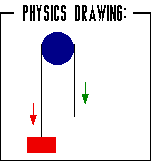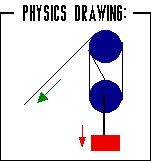|
|

|
| |
The Machines
Pulleys
A pulley is a machine that is used to lift a load. It uses a wheel and axle that is either mounted or is freely moving, and a string that is wrapped around the pulley. This enables a pulley to lift a load. Here is a simple pulley setup:

A simple pulley setup.
Drawing Analysis:
- Green Arrow: This arrow represents the direction a person must pull to get the load to raise up.
- Red Arrow/Box: This is the load force on the pulley.
- Blue Circle: This represents the wheel and axle portion of the pulley.
This is only a simple pulley setup that does nothing more than change the direction that the input force is applied. There is an easy way you can tell how much mechanical advantage a pulley has, and that is by the number of ropes supporting the load. In the drawing above only 1 rope supports the rope, and that is the one on the left. The one on the right is not connected to the load so we can say the above pulley setup has a mechanical advantage of 1.
Mechanical Advantage & Pulleys
The following is a mechanical advantage problem that relates to pulleys. If you are unfamiliar with the concept of mechanical advantage I suggest you head to the second section of the introduction.
Consider the following complex pulley setup:

A complex pulley setup.
Sue used this pulley to lift her 445N boulder onto the back of her pickup truck. Based on what you see how much force did Sue have to exert to get the boulder to move? If the distance she needed to raise the boulder was 2 meters, how much energy did she exert on the boulder?
Select the appropriate answer and hit the 'answer' button:
|
|
|


